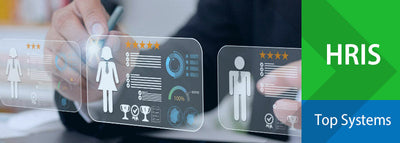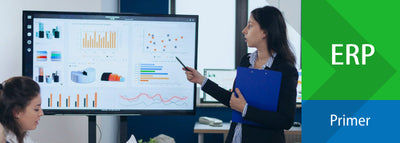Essential Supply Chain Management (SCM) Software Requirements & Features: Buyer's Guide
Supply chains have become increasingly complex, with global disruptions, shifting consumer demands, and ongoing digital transformation. Businesses need supply chain management (SCM) software to improve efficiency, enhance visibility, and adapt to changing conditions.
In this guide, we’ll cover the essential components of modern supply chain software, key features to consider, and notable solutions in MRP, Distribution, Logistics, WMS, Procurement, and Transportation. We’ll also discuss the benefits of integrated supply chain systems and trends shaping SCM in 2025.
What is Supply Chain Management Software?
Supply Chain Management (SCM) software is a suite of digital tools designed to streamline and optimize the flow of goods, services, and information across a supply chain network. It covers various aspects, including manufacturing, procurement, logistics, inventory management, and transportation. The goal is to improve efficiency, reduce costs, and enhance visibility throughout the supply chain.
Supply Chain Management software integrates multiple functions into a centralized platform, With the right SCM system, businesses can:
-
Track inventory in real-time
-
Plan production more effectively
-
Build stronger relationships with suppliers
-
Keep deliveries on schedule
-
Minimize costs and inefficiencies
In short, it helps ensure the supply chain operates as smoothly as possible.
Key Trends Making SCM Software Essential in 2025

1. Artificial Intelligence & Machine Learning (AI & ML)
AI-powered SCM software transforms supply chain operations by improving demand forecasting, predictive analytics, and automation. Machine learning algorithms analyze vast datasets to predict market demand, supplier reliability, and inventory fluctuations, allowing businesses to make proactive, data-driven decisions. AI also enhances automated procurement and smart warehouse management, reducing operational costs and human errors.
2. Blockchain for Supply Chain Transparency
Blockchain technology is revolutionizing supply chain security and transparency by creating immutable records of transactions. This ensures:
-
Traceability: Companies can track goods from production to delivery, reducing fraud and counterfeiting.
-
Smart Contracts: Automated contract execution eliminates disputes and delays.
-
Supplier Compliance: Businesses can verify ethical sourcing and regulatory adherence in real-time.
3. IoT & Real-Time Data Tracking
The Internet of Things (IoT) plays a crucial role in improving supply chain visibility. Sensors and connected devices provide real-time updates on shipments, warehouse stock, and fleet management. Key benefits include:
-
Automated inventory management to prevent stockouts and overstocking.
-
GPS-enabled fleet tracking for accurate delivery timelines.
-
Condition monitoring for perishable and sensitive goods (e.g., pharmaceuticals, food, electronics).
4. Cloud-Based & SaaS SCM Solutions
Cloud-based SCM solutions are becoming the standard due to their scalability, cost-effectiveness, and remote accessibility. These solutions offer:
-
On-demand access to supply chain data from anywhere in the world.
-
Seamless integration with other enterprise systems like ERP and CRM.
-
Lower IT maintenance costs, as updates and security measures are managed by the provider.
5. Sustainability & Green Supply Chains
With increasing regulations and consumer demand for eco-friendly business practices, supply chains are prioritizing sustainability. SCM software helps companies:
-
Reduce carbon footprints by optimizing transportation routes and reducing waste.
-
Ensure ethical sourcing by tracking suppliers’ sustainability practices.
-
Implement circular supply chain models, such as recycling and reusing materials.
Essential Features of Supply Chain Management Software

1. Manufacturing Resource Planning (MRP)
Overview: MRP systems help manufacturers plan, schedule, and control production processes. They manage raw materials, production timelines, and inventory to prevent shortages and overstocking. With advanced analytics and AI-driven insights, MRP solutions optimize manufacturing efficiency and reduce costs.
Top Features:
-
Demand Forecasting
-
Inventory Management
-
Production Scheduling
-
Bill of Materials (BOM)
-
Supplier Collaboration
-
AI-Driven Production Planning
Leading Solutions:
-
Oracle NetSuite MRP
-
SAP Business One MRP
-
Microsoft Dynamics 365 Supply Chain Management
Benefits:
-
Improved production efficiency and reduced lead times
-
Lower material waste and optimized resource utilization
-
Enhanced supplier coordination and cost savings
2. Distribution Software
Overview: Distribution software helps businesses streamline order fulfillment, inventory tracking, and warehouse management. By integrating real-time demand signals and automation, distribution solutions ensure accurate deliveries and reduced order processing times.
Top Features:
-
Multi-Channel Order Management
-
Automated Replenishment
-
Route Optimization
-
Demand Planning
-
AI-Powered Inventory Forecasting
Leading Solutions:
-
Blue Yonder Luminate
-
SAP Extended Warehouse Management
-
Oracle SCM Cloud
Benefits:
-
Faster order processing and improved customer satisfaction
-
Reduction in stockouts and overstocking issues
-
Increased supply chain visibility and operational agility
3. Logistics Management
Overview: Logistics software ensures efficient transportation, delivery, and inventory movement across the supply chain. It integrates AI and IoT technologies to enhance real-time visibility and reduce shipping delays.
Top Features:
-
Real-Time Shipment Tracking
-
Freight Optimization
-
AI-Powered Route Planning
-
Predictive Analytics
-
Automated Freight Billing & Auditing
Leading Solutions:
-
Manhattan Associates TMS
-
Oracle Transportation Management
-
Blue Yonder Logistics Management
Benefits:
-
Reduced transportation costs through route optimization
-
Increased on-time deliveries with real-time tracking
-
Improved compliance with international shipping regulations
4. Warehouse Management Systems (WMS)
Overview: WMS software optimizes warehouse operations, including inventory control, order fulfillment, and labor management. Automation and robotics integration are transforming warehouse efficiency and reducing operational costs.
Top Features:
-
Barcode & RFID Scanning
-
Automated Picking & Packing
-
Real-Time Inventory Visibility
-
Robotics & AI Integration
-
Labor Management & Workforce Optimization
Leading Solutions:
-
SAP Warehouse Management
-
Manhattan Associates WMS
-
Blue Yonder WMS
Benefits:
-
Enhanced inventory accuracy and reduced stock discrepancies
-
Faster order fulfillment with automation-driven processes
-
Better labor allocation and workforce productivity
5. Procurement Software
Overview: Procurement solutions help businesses manage supplier relationships, purchasing processes, and cost control. AI-powered procurement tools improve sourcing decisions and enable smarter contract negotiations.
Top Features:
-
Supplier Management
-
Spend Analytics
-
eProcurement & Contract Management
-
AI-Powered Negotiation
-
Automated Purchase Requisitions
Leading Solutions:
-
SAP Ariba
-
Oracle Procurement Cloud
-
Coupa Procurement
Benefits:
-
Cost savings through better supplier negotiations
-
Reduced procurement cycle times with automation
-
Improved compliance with procurement policies and contracts
6. Transportation Management Systems (TMS)
Overview: TMS software optimizes freight management, reducing costs and improving delivery efficiency. Cloud-based TMS solutions provide real-time carrier communication and shipment tracking.
Top Features:
-
Fleet Management
-
Route Optimization
-
Freight Audit & Payment
-
Real-Time Carrier Communication
-
AI-Powered Load Planning
Leading Solutions:
-
MercuryGate TMS
-
Oracle Transportation Management
-
SAP TMS
Benefits:
-
Improved shipment accuracy and reduced freight costs
-
Increased visibility into logistics operations
-
Faster response to supply chain disruptions
Evaluating the Right SCM Software for Your Business
Conduct a Needs Assessment
-
Identify key pain points in your current supply chain operations.
-
Determine must-have features and functionalities.
-
Assess future growth plans and scalability requirements.
Compare SCM Systems
-
Research leading SCM vendors and their offerings.
-
Evaluate pricing, deployment options, and integrations.
-
Consider customer reviews and industry benchmarks.
-
What level of customization does your software offer?
-
How does your solution handle real-time data tracking?
-
What kind of support and training do you provide?
-
How does your system integrate with existing ERP or third-party solutions?
Conclusion
Choosing the right supply chain software depends on your business’s size, industry, and operational challenges. Investing in an integrated solution ensures better visibility, cost savings, and improved efficiency across your supply chain network.
Explore the best SCM software solutions for 2025 to future-proof your operations and stay competitive in the evolving digital landscape.
Helpful Resources for Choosing the Right Supply Chain Management (SCM) Software
Looking for more insights on selecting the best SCM software? Explore these valuable resources:
-
Compare the Best Supply Chain Management Software – View top solutions
-
Best SCM Software for Small Businesses: NetSuite vs. Sage Business Cloud X3 vs. Logility – Compare solutions
-
Best Supply Chain Management Software: Oracle SCM Cloud vs. Blue Yonder vs. NetSuite – Explore top contenders
-
Best Warehouse Management Software: Oracle WMS vs. Korber vs. Fishbowl Warehouse – Compare WMS solutions
-
Free Detailed Comparison of Top SCM Systems – Download Free Report
-
Best Supply Chain Management Software: Oracle SCM Cloud vs. Blue Yonder vs. NetSuite - Download Free Report








